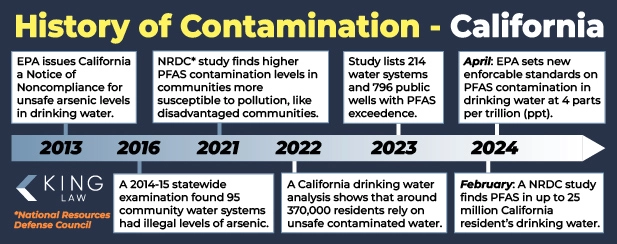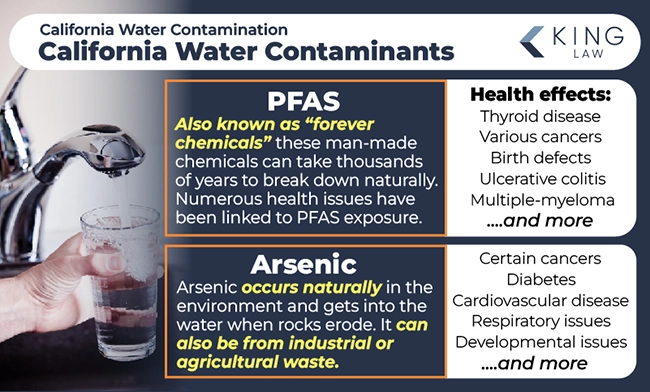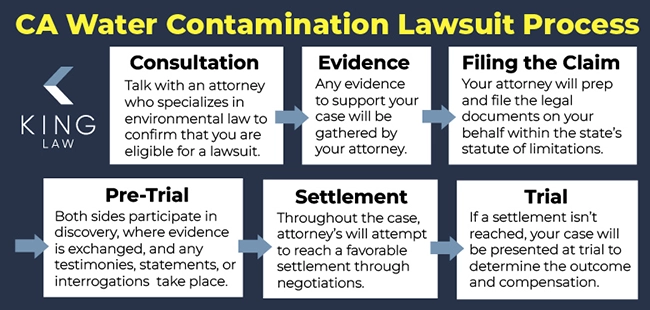
California has played an important role in American culture. The state’s prominence took off in the 19th century during the Gold Rush when there was a huge population boom in response to the discovery of gold. The state continued to expand and become popular thanks to its diverse geographic landscape, plentiful natural resources, and great location for agriculture, trade, and more. Many associate California with the American Dream thanks to its widespread opportunities and cultural diversity.
Today, California is a global epicenter for initiatives like technological innovations, entertainment, cultural diversification, and environmental policy. It continues to set the tone for trends across the country and is a key player in both national and international industries. Unfortunately, natural resources, industrialization, and military activity throughout the state have contributed to drinking water contamination that now affects millions.
California Water Contamination Lawsuit Overview & Updates
California workers and residents continue to file lawsuits against chemical manufacturers, like those who create products with PFAS, after being exposed to toxins in drinking water and developing serious illnesses Thousands are seeking legal action to gain compensation to help with treatment costs, lost wages, and other damages. King Law is dedicated to helping victims get the support they need by offering experienced, personalized legal counsel.
California continues to monitor and address PFAS concerns. However, the widespread nature of contamination leaves many communities, especially those that are vulnerable, with no choice but to continue consuming toxic water. In April 2024, several of the state’s public water systems decided to file a lawsuit against PFAS manufacturers to help with clean water initiatives. This lawsuit leverages the EPA’s decision to finally put enforceable PFAS drinking water limits into place.
About California Water Contamination:
History of Water Contamination in California
Sources of Water Contamination in California
California Water Contamination Map
Contaminants Found in California Drinking Water
Current Water Quality in California
Health Risks and Symptoms Linked to Drinking Water in California
Eligibility Criteria for the California Water Contamination Lawsuit
California Water Contamination Settlement and Payout Amounts
How to File a California Water Contamination Lawsuit
Statute of Limitations for California Water Contamination Claims
History of Water Contamination in California
California has spent over a decade battling unsafe levels of arsenic, PFAS, and other contaminants:
- April 2024: Nationwide enforceable PFAS limits in drinking water prompt concerns about how much California will have to spend to address contamination with the number of wells with PFAS exceedances expected to grow by 255% under the new standards.
- February 2024: A Natural Resources Defense Council (NRDC) study finds PFAS in the drinking water of up to 25 million California residents.
- 2023: Data from a 2023 CalMatters study lists 214 water systems and 796 public wells with PFAS exceedances over 4 ppt (the new federal standard).
- January 2022: A California drinking water analysis by Berkeley details how at least 370,000 residents rely on drinking water potentially contaminated with unsafe levels of contaminants including arsenic, nitrate, and hexavalent chromium.
- August 2021: An NRDC study finds higher levels of PFAS contamination in communities susceptible to other forms of pollution, especially in disadvantaged communities. Maximum PFAS levels were 1,380.1 ppt for Fresno, 1,276.1 ppt for Corona, and 698.9 ppt for San Diego.
- September 2016: A statewide examination of data through 2014 and 2015 found that 95 community water systems providing water to more than 55,000 people had illegal levels of arsenic.
- 2013: The EPA issues California a Notice of Noncompliance for unsafe levels of arsenic in drinking water.

Sources of California Water Contamination
The main source of arsenic in California water is from natural sources. Arsenic is found in geographical formations and can be disturbed during erosion or human activities like drilling and mining. Arsenic can enter the soil and groundwater, then contaminating drinking water sources. The California State Water Resources Control Board (CSWRCB) also cites volcanic activity and forest fires as two of the most common natural sources of arsenic in groundwater.
When it comes to PFAS, a 2021 report by NRDC identified landfills, wastewater treatment plants, oil and gas facilities, metal plating facilities, and airports as likely sources of drinking water contamination. Military bases in California are also likely sources based on historical use of PFAS-containing firefighting foam.
California Water Contamination Map
Reference our California water contamination map for a better idea of how widespread contamination is across the state. Color coding shows different levels of PFAS found in drinking water samples. Keep in mind that today’s enforceable limits are 4ppt for PFOA and 4ppt for PFOS. In many communities, levels far exceeded this limit.
Contaminants Found in California Drinking Water
Two of the main contaminants of concern in California drinking water include PFAS and arsenic. Both toxins can cause multiple different types of cancers and other life-changing health conditions.
Per- and Polyfluoroalkyl Substances (PFAS)
Per- and polyfluoroalkyl substances (PFAS), known as “forever chemicals,” are toxic compounds that do not break down in the environment or in the human body. Military activities are a major source of PFAS contamination in drinking water. Firefighting foam used by the military, which contains PFAS, was applied during fire training and to put out fires. This foam often ended up on the ground or seeped into groundwater due to poor storage, spills, or disposal.
PFAS contamination is a significant issue across California and is associated with:
- Birth defects
- Bladder cancer
- Breast cancer
- Changes in liver enzymes
- Decreased vaccine effectiveness
- Hodgkin’s and non-Hodgkin’s lymphoma
- Leukemia
- Lowered immune response
- Multiple-myeloma
- Kidney cancer
- Pancreatic cancer
- Prostate cancer
- Reproductive issues
- Testicular cancer
- Thyroid cancer
- Thyroid disease
- Ulcerative colitis
Arsenic
Arsenic in California’s drinking water is a serious health risk, especially in areas reliant on groundwater. Long-term exposure, even at low levels, can lead to severe health problems. Many residents, particularly private well owners, may be unaware of the arsenic levels in their water, resulting in chronic exposure. The health risks associated with arsenic include:
- Skin lesions and changes in skin pigmentation
- Increased risk of skin, lung, and bladder cancers
- Cardiovascular disease
- Developmental effects in children
- Impaired immune function
- Diabetes
- Respiratory issues

Current Water Quality in California
According to recent records, around 98% of California residents have water that meets state standards. However, many drinking water sources are handled by state regulations, especially those in rural and disadvantaged communities. A June 2024 article cites around 380-400 failing water systems with more added every year. While the state is making progress toward providing clean drinking water for all Californians, a state auditor notes that it’s taking too long with a lack of urgency.
Water Treatment Efforts in California
California continues to monitor water contaminants across the state, though it has fallen short when it comes to disadvantaged communities. Water treatment efforts thus far have involved an extensive water quality report and cleanup tracker, advanced purification systems, new water treatment plants, and advancements in their water filtration techniques. One of the state’s latest initiatives is to turn sewage into drinking water.
Health Risks and Symptoms Linked to Drinking Water in California
There are a multitude of health risks associated with PFAS and arsenic in California’s drinking water, including:
- Birth defects
- Bladder cancer
- Breast cancer
- Changes in liver enzymes
- Decreased vaccine effectiveness
- Hodgkin’s and non-Hodgkin’s lymphoma
- Leukemia
- Lowered immune response
- Multiple-myeloma
- Kidney cancer
- Pancreatic cancer
- Prostate cancer
- Reproductive issues
- Testicular cancer
- Thyroid cancer
- Thyroid disease
- Ulcerative colitis
- Liver cancer
If you think you’ve been exposed to toxic drinking water, let your healthcare provider know immediately. Regular checkups and screenings can help catch health issues early, leading to quicker treatment. If you’re diagnosed with related illnesses, consider exploring legal options for compensation to help with medical costs.
Eligibility Criteria for the California Water Contamination Lawsuit
To pursue a water contamination lawsuit in California, individuals must meet the following criteria:
Duration of exposure: You should have lived or worked in the affected area for at least six months during the contamination period.
Related Diagnoses: Our firm is evaluation cases with a diagnosis of:
- Kidney cancer
- Liver cancer
- Testicular cancer
- Thyroid cancer
- Thyroid disease
- Ulcerative colitis
Supporting documents: You will need medical records confirming your diagnosis and proof of residence or employment during the contamination period, such as utility bills, lease agreements, or employment records.
Meeting these criteria is crucial for building a strong legal case and enhancing the likelihood of obtaining compensation. Consulting with specialized attorneys, such as those at King Law, can help navigate the legal process effectively.
California Water Contamination Settlement and Payout Amounts
Several factors affect settlement amounts in California water contamination lawsuits. Key considerations include the level of exposure to contaminants and the documented health issues linked to that exposure. The length of time a person lived or worked in the affected area also impacts the settlement, with longer exposure generally leading to higher payouts. Younger individuals at the time of diagnosis or those with severe, long-term illnesses may receive larger settlements due to the greater impact on their quality of life and future earnings.
Past settlements typically range from $30,000 to $300,000. Settlements are often lower than potential trial verdicts but avoid the risk of getting nothing at trial if it doesn’t resolve in your favor. Those affected by water contamination should consult legal experts to explore their options and potential compensation.
How to File a California Water Contamination Lawsuit
Filing a water contamination lawsuit in California involves several steps:
- Initial Consultation: Meet with a lawyer who specializes in environmental law to confirm your eligibility and start the process.
- Gather Evidence: Collect documentation such as medical records, proof of residence or employment, and environmental reports to support your case.
- Legal Filing: Your lawyer will prepare and file the legal documents, including a complaint detailing your allegations and the damages sought. This must be done within the statute of limitations, which is typically three years from your diagnosis.
- Pre-Trial Procedures: Engage in discovery, where both sides exchange evidence. This phase may also involve depositions and interrogatories to gather more information.
- Settlement Negotiations: Many cases are settled before trial. Your lawyer will negotiate with the defendants to secure a fair settlement for your damages.
- Trial: If a settlement isn’t reached, your case will go to trial. Your lawyer will present your case to a judge or jury, who will determine the outcome and compensation.
Working with a lawyer familiar with California’s regulations and environmental litigation can help make the process as smooth as possible. Contact King Law today to get started.

Evidence to Support Your California Water Contamination Claim
In California water contamination cases, proving your claim requires evidence linking toxic exposure to health problems. This validates your claim to help make sure you recover adequate compensation. Key types of evidence include:
- Medical Records: Documentation of diagnoses, treatments, and health issues associated with toxic exposure.
- Proof of Residence or Employment: Utility bills, lease agreements, or employment records that show you lived or worked in the contaminated area during the relevant period.
- Environmental Reports: Studies detailing the levels of contaminants in the water supply.
- Expert Testimonies: Opinions from medical professionals connecting health conditions to the exposure, and from environmental experts verifying the contamination.
- Personal Accounts: Descriptions of your exposure, health problems, and the impact on your daily life.
- Receipts and Bills: Records of medical expenses and healthcare costs related to the exposure.
Begin collecting evidence as soon as possible. A toxic tort attorney can also help you understand what type of proof will help bolster your case.
Statute of Limitations for California Water Contamination Claims
Understanding the statute of limitations is key for anyone pursuing a California water contamination lawsuit. Deadlines can vary based on the case details and state laws, so consulting an attorney who specializes in environmental or personal injury law is crucial to ensure you don’t miss the filing window. Contact us today or fill out our online form to start your case and increase your chances of a successful claim. We’re here to help you seek justice and compensation.
California Water Contamination Lawyers
At King Law, we specialize in water contamination lawsuits, particularly involving PFAS. Our team offers extensive expertise in environmental law, handling everything from evaluating your claim and preparing documents to negotiating settlements and representing you in court.
With our deep knowledge of environmental regulations and legal requirements, we ensure every aspect of your case is thoroughly managed. Contact King Law today for a free consultation and let us help you navigate your water contamination claim.
Frequently Asked Questions (FAQs)
Read the following frequently asked questions for more information on California water contamination.

